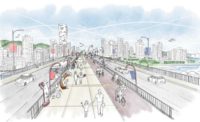Safety & Health
WSDOT Deploys Orange Road Striping to Increase Work Zone Awareness

Orange pavement striping on I-5 near Fife, Wash. are part of a WSDOT program to increase driver awareness of work zones.
Photo courtesy WSDOT
The orange striping through an Interstate 5 work zone in Fife, Washington, has drivers taking notice. That’s the entire point.
As part of a pilot program approved by the Federal Highway Administration, the Washington State Dept. of Transportation and contractor Guy F Atkinson Construction painted both northbound and southbound Interstate 5 lane stripes a combination of white and orange for about three-quarters of a mile through a 1.5-mile-long work zone in June as part of the $2.69 billion State Route 167 Completion Project.
Half of each lane stripe is still white, while the other half is orange.
“WSDOT is committed to improving driver and worker safety,” Tom Slimak, WSDOT project engineer for the Highway 167 project, says in a statement. “This includes carefully trying new strategies that could help improve safety for both workers and drivers in work zones.”
The colored stripes, which appear as divers approach a lane shift and end shortly after drivers move back to the traditional route, will remain until fall 2023 when the lane lines return to conventional white striping. The fog lines that separate the shoulders from the lanes were not painted orange.
A WSDOT spokesperson tells ENR that the lane shift needed to build two new bridges offered the ideal test case. “Using color-coordinated contrast striping may help reduce driver confusion in construction areas where lane shifts often leave behind ghost lines or scarring from removal of previous pavement lines,” WSDOT says.
Similar tests of orange striping have already been done in California, Kentucky, Indiana, Texas and Wisconsin. While these pilot programs have placed orange paint next to the white lines or completely replaced white with orange, Washington created the combination stripe design using an orange color close to the shade found in construction zones.
WSDOT doesn’t expect to have any data until sometime after the pilot project is completed, likely in early 2024. Anecdotally, a WSDOT spokesperson tells ENR they’ve heard people say the color helped bring more attention to the work zone. WSDOT has also set up a survey available through July 30 for drivers who have gone through the zone.
The striping strategy is one of many initiatives to enhance work zone safety nationally. A recent survey of highway construction firms by the Associated General Contractors of America noted more than 55% of respondents had experienced work zone crashes during the past 12 months. Nearly all the respondents reported that work zones are either as dangerous, or more dangerous, than they were a year ago.
Work zone collisions account for 95% of the individuals hurt in construction work zone accidents in Washington, Slimak says. In the test, WSDOT will research if the contrast striping enhances driver awareness of the work zone, improves ability to maintain lanes, improves compliance with posted work zone speed limits and if they reduce work zone collisions.
Washington reported 1,192 work zone collisions in 2022 and Pierce County, the location of the Fife pilot project, recorded 274 (22%) of those incidents.
FHWA is expected to compare the results of field tests in other states with new data from the Washington effort to evaluate whether orange contrast striping offers an effective method in improving highway work zone safety.
An analysis compiling various state efforts to utilize orange striping by Indiana State University earlier this year found that survey respondents preferred the striping and it helped make them more aware of work zones. Yet the same report found little indication that the markings encouraged drivers to abide by posted speed limits in the study areas.
A 2021 study by the Kentucky Transportation Center of the orange striping program in that state came to similar results but also noted an increase in the total number of crashes when orange pavement markings were installed, but there was a large decrease in wet-road surface and nighttime crashes. It cautioned that the study was not large enough to provide conclusive evidence regarding the use of such striping.
For WSDOT the orange stripes aren't intended to be a final solution regarding work zone safety.
“We want to make sure everyone gets home safely,” Slimak says. “Orange striping could be one more tool in our toolbox to make sure that happens.”


